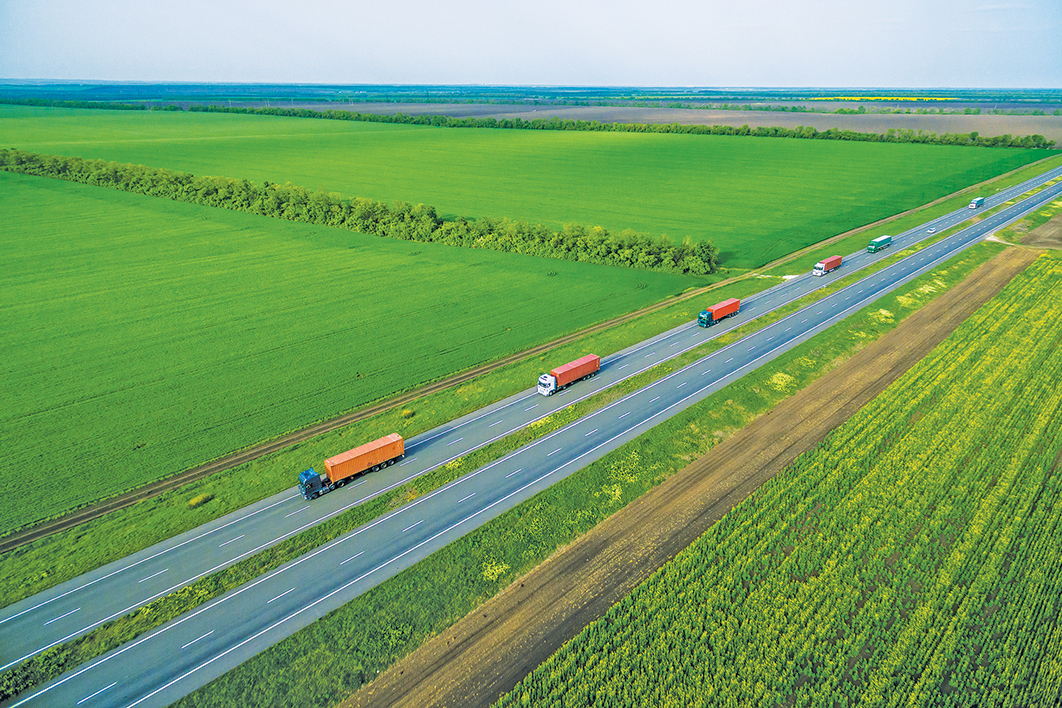On the Saturday before Easter 2020, I set off on a drive from Baltimore, where I live, to Pittsfield, Massachusetts, where I grew up. Stay-at-home orders were in effect, but I decided that a visit to my parents, whom I had not seen in several months, qualified as essential. I would stay elsewhere for the night, and we would go for an Easter Sunday walk.
I departed Baltimore in the early evening. Interstate 95, the perpetually clogged corridor of the Eastern Seaboard, was emptier than I had ever seen it. Digital highway signs overhead declared “Save Lives Now. Stay Home.” I had never been in the vicinity of a war zone, but it occurred to me that it might feel something like this — only the most essential or foolhardy travellers on the roads, the rest of the world hunkered down.
Except there were no troop carriers or munitions haulers in this war zone. Instead, there were trucks. The majority of the few vehicles on the road were semitrailers, and the biggest group among them were Amazon trucks. I counted two dozen on the hundred-mile stretch between Baltimore and southern New Jersey, where it got too dark to see logos. I had seen many, many Amazon trucks on my travels around the country over the past few years. I had never seen a concentration anywhere close to this.
If we were in a war against the coronavirus, then Amazon was our troop carrier. In this war, mobilising to attack the enemy meant universal withdrawal and self-isolation, and Amazon was supplying that mobilisation by bringing us everything at home, allowing us to stay there. All at once, it had become our civic duty, our cause larger than ourselves, to fulfil our needs online. An act of convenience that had once been tinged — at least for some — with misgivings was now infused with righteousness. By placing a one-click order, one was flattening the curve.
The boxes came, in great numbers. Often, they sat on porches or in garages for a day or two in case they’d been tainted with viral particles by their delivery handler. When this quarantine passed, the boxes were allowed into the home.
The boxes came in such quantity, the orders were placed in such quantity, that the company famed for its peerless logistics operation was for once having trouble keeping up. It announced it was hiring 100,000 more workers at its warehouses, then a few weeks later announced it was hiring 75,000 more. It told buyers and third-party sellers that it was deprioritising orders deemed less than essential. In the most startling move of all, it briefly removed some of the web features intended to get shoppers to buy more from the site — Amazon was for once discouraging people from spending more money. The company had seen into the future, when it would truly be the Everything Store, the Be-All, End-All Store, but it wasn’t ready to carry it off. Not yet.
Such emergency measures were temporary. The usual buying goads returned, as did the non-essential items. It emerged that the company’s algorithms were in fact finding new ways to drive product makers to sell goods only on the site, rather than through other retailers. And as the peak of the spring 2020 national crisis passed, certain consequences became unmistakable. The pandemic had taken a series of related developments in American life and accelerated them to hyper-speed, like a film reel gone haywire.
The news organisations that had already lost the majority of their advertising revenue to Silicon Valley were now losing what little remained as a result of the halt in commerce. To try to survive, many furloughed their entire newsrooms, on rotating shifts, leaving them understaffed to cover first one huge story, the pandemic, and then another, the protests over George Floyd’s death at the hands of a police officer in Minneapolis.
The legacy retail companies that had survived the upheaval of the prior two decades were now careening towards extinction. JCPenney, Neiman Marcus and J.Crew filed for bankruptcy. Macy’s temporarily shuttered all 775 of its stores and furloughed nearly all of its 125,000 workers; after its stock fell by 75 per cent in two months, it was dropped from the S&P 500. Amazon’s Seattle neighbour, Nordstrom, announced it was laying off thousands. The toll was no less widespread among the country’s independent businesses. All told, 25,000 retail stores were expected to go out of business by the end of 2020, a figure that nearly tripled the mass closure figures of recent years.
Meanwhile, the companies that had for several decades been capitalising on the trends reshaping the economy were growing larger and more successful in what seemed like the exact inverse of the economic haemorrhage under way all across the country. By late May, the five biggest tech companies — Apple, Facebook, Microsoft, Amazon, and Google’s Alphabet — had added a stunning US$1.7 trillion to their combined market cap in just two months, a rise of 43 per cent. The combined value of only these five companies was now a fifth of the S&P 500.
And they were only going to grow larger: the five were sitting on a combined US$557 billion in cash. They used it to finance new acquisitions and raise their spending on research and development to nearly US$30 billion a year — more than NASA’s entire budget — even as their smaller rivals were retrenching. “What is unusual at this moment is the extreme divergence in the health of different types of companies,” wrote economist Austan Goolsbee, a former adviser to Barack Obama. “Many of the biggest are flush with money, while smaller competitors have never been in more precarious shape.”
The biggest winner of all was Amazon. Its first-quarter sales were up by more than 25 per cent over those the year prior — this, at a time when overall retail sales were plunging. Its stock surged so much in mid April — up by more than 30 per cent on the previous year, as the pandemic was nearing its deadliest period — that Jeff Bezos’s net worth increased by US$24 billion in the span of only two months. In late July, Amazon announced that its profit had doubled in the second quarter, with sales up by a stunning 40 per cent from those a year earlier. On the news, its share price surged yet higher — by early September, it was up by 84 per cent on the year, more than double the rise of other tech giants. “Simply put, Covid-19, in our view, has injected Amazon with a growth hormone,” wrote one industry analyst in a note to investors.
To handle the surge in business, the company had added more than 425,000 employees worldwide between January and October, bringing its total number of non-seasonal employees in the United States to 800,000 and its global total to more than 1.2 million — up by half from a year earlier and now behind only Walmart and China National Petroleum (and that tally didn’t even include the 500,000 drivers who were delivering its packages). To house these workers, the company went on a building and leasing spree, opening one hundred buildings in September on its way to occupying nearly one hundred million additional square feet of warehouse space by the end of 2020, a roughly 50 per cent increase. Its warehouses weren’t the only part of the company in high demand: its data centres were ramping up capacity for customers like Zoom, as hundreds of millions of daily human interactions shifted online.
The midsummer announcement of Amazon’s massive pandemic profits had come on the same day that the federal commerce department reported that the US economy had shrunk by nearly 10 per cent, the largest quarterly drop on record. In other words, Amazon was flourishing more than ever before at one of the lowest moments for the country as a whole: the fates of the company and the nation had diverged entirely.
Such profound imbalance in fortunes had contributed greatly to the political convulsions of the era. And, as the dread year of 2020 neared its close, it was plain that one of the first orders of business facing the newly elected president, Joe Biden, and his incoming administration would be deciding how to address the divergence. The nation could hardly afford for it to grow any wider.
In Baltimore, a twenty-six-year-old woman named Shayla Melton was trying to decide whether to go back to work at Amazon. She had been working as a picker at the Broening Highway warehouse, where the GM plant used to be, until she had her baby, her second child, just as the pandemic was arriving. Her husband also worked as a picker, but at the other Amazon warehouse, at Sparrows Point, and he, too, had taken time off from the job, because there had been a lot of coronavirus cases there.
The company’s initial reaction to the pandemic was to announce that it was seeding a charitable fund for its temp workers and contract delivery drivers who lacked health coverage and to encourage the public to donate to it. This met with some derision. It also promised two weeks of paid leave to anyone with a Covid-19 diagnosis and offered unpaid time off, without risk of being penalised for missing shifts, to anyone who wanted to stay home as a precaution. It offered a temporary US$2 bump in hourly pay to those who kept working. It set up temperature checks and Covid-19 testing stations for arriving workers. It issued masks and provided hand sanitiser and disinfectant.
Hector Torrez, who once had a highly paid tech-industry job, watched the measures go into effect at the warehouse in Thornton, Colorado, where he was now stacking, packing and loading. A small army of cleaners came in one day, wearing what looked like suits from Ghostbusters. The usual group stretching routine at shift start was cancelled, which made the physical work only riskier, as did the fact that jobs like loading boxes into trucks now had to be done solo, without a partner. What most upset Hector was the contrast with the company’s headquarters employees, who were being allowed — encouraged — to work from home.
Meanwhile, the new hires kept arriving. Several had backgrounds as elevated as Torrez’s own: a former industrial engineer, a former litigator, a former owner of a real estate firm. “What I see around me is a lot of people who don’t have much choice,” he said. “We’re economic refugees.” Many other workers were quite young, and Hector would strike up conversations with them and urge them to move on as quickly as they could. “Time passes,” he told them. “Get out when you still have time, and can still make a decision.”
At the company’s warehouses in France, union demands over safety measures had forced a weeks-long shutdown and an eventual deal that included a reduction of shifts by fifteen minutes, without a reduction to pay, to allow for more social distancing at crowded shift changes. In the absence of unions at the US warehouses, discontent took other forms. “Welcome to Hell” read the graffiti inside truck trailers, out of sight of warehouse cameras. “Fuck Bezos.” Workers began sharing their disquiet in online back channels, and at some warehouses, they organised protests, signalling that the pandemic just might set in motion a new era of workplace activism.
The company moved to head off any such swell. It fired a worker who organised a walkout at the huge warehouse in Staten Island, saying he violated safety protocol by coming to the warehouse while under self-quarantine for having had contact with an infected worker. It also fired two headquarters employees in Seattle who had spoken up for the protesting warehouse workers.
More than worker activism alone would be necessary to provide a check on so vast and powerful a company, as well as its fellow industry giants. It would require federal action. Joe Biden’s election victory showed a continuation of the political trends of the era: Democrats strengthened their hold on wealthy suburbs, while making up scant ground in the struggling rural areas and small towns that had elected Donald Trump. Ominously for Democrats, there were signs that, as they transformed into the party of highly educated urban professionals, their erosion of support in white working-class communities was spreading to Hispanic voters and Black men.
It will be up to Biden, his new administration and Democrats in Congress to decide whether to deal with that erosion, and the great class and regional imbalances that lie behind it, by challenging their party’s long-time natural allies in the tech industry. •
This is an edited extract from Fulfillment: Winning and Losing in One-Click America, published this week by Scribe.




